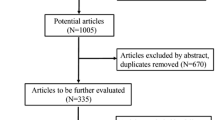Abstract
Background
Endoscopic transthoracic sympathicotomy has proven to be an effective and durable surgical treatment for severe primary hyperhidrosis. Anyhow, in some cases, especially in overweight patients, a thick overlying subpleural fat may obscure the sympathetic chain, precluding access to the ganglia and partial or total completion of the procedure. The aim of this study was to assess the value of palmar laser Doppler flowmetry (LDF) as an intraoperative-aid during minimally invasive dorsal sympathicotomies (T3) for the treatment of primary palmar hyperhidrosis.
Methods
The method was tested during 40 upper dorsal video-assisted minimally invasive sympathicotomies in 20 patients with bilateral palmar primary hyperhidrosis.
Results
The mean baseline LDF values were 36.05 pU (SD = 21.85 pU). The mean immediate postoperative LDF values were 75.94 pU (SD = 37.89 pU). A statistically significant difference was observed between preoperative and immediate (about 5 s after the sympathicotomies) postoperative values (p = 0.00000009).
Conclusions
According to our data, LDF allowed to obtain reliable and fast intraoperative evidence of a correct section of T3 ganglia. As such, we recommend LDF as a useful intraoperative tool when dealing with dorsal sympathicotomies for the treatment of palmar hyperhidrosis, both for the unexperienced surgeon and when the sympathetic chain is not clearly visualized.
Level of Evidence: Level IV, therapeutic study.


Similar content being viewed by others
References
Muthusamy A, Gajendran R, Ponnan S, Thangavel D, Rangan V (2016) A study on the impact of hyperhidrosis on the quality of life among college students. J Clin Diagn Res 10(6):CC08–CC10
Fujimoto T, Kawahara K, Yokozeki H (2013) Epidemiological study and considerations of primary focal hyperhidrosis in Japan: from questionnaire analysis. J Dermatol 40(11):886–890
Cerfolio RJ, De Campos JR, Bryant AS et al (2011) The Society of Thoracic Surgeons expert consensus for the surgical treatment of hyperhidrosis. Ann Thorac Surg 91(5):1642–1648
de Andrade Filho LO, Kuzniec S, Wolosker N, Yazbek G, Kauffman P, Milanez de Campos JR (2013) Technical difficulties and complications of sympathectomy in the treatment of hyperhidrosis: an analysis of 1731 cases. Ann Vasc Surg 27(4):447–453
Chuang TY, Yen YS, Chiu JW, et al (1997) Intraoperative monitoring of skin temperature changes of hands before, during, and after endoscopic thoracic sympathectomy: using infrared thermograph and thermometer for measurement. Arch Phys Med Rehabil 78(1):85–88
Kao MC, Tsai JC, Lai DM, Hsiao YY, Lee YS, Chiu MJ (1994) Autonomic activities in hyperhidrosis patients before, during, and after endoscopic laser sympathectomy. Neurosurgery 34(2):262–268
Lee KH, Hwang PY (1996) Video endoscopic sympathectomy for palmar hyperhidrosis. J Neurosurg 84(3):484–486
JJ W, Hsu CC, Liao SY, Shih CJ (1996) Contralateral temperature changes of the finger surface during video endoscopic sympathectomy for palmar hyperhidrosis. J Auton Nerv Syst 59:98–102
Kao MC (1992) Video endoscopic sympathectomy using a fiberoptic CO2 laser to treat palmar hyperhidrosis: technical report. Neurosurgery 30(1):131–135
Lenasi H (2011) Assessment of human skin microcirculation and its endothelial function using laser Doppler flowmetry. In: Erondu OF (ed) Medical Imaging. Shangai: InTech, pp 271–296. https://doi.org/10.5772/27067
Bej MD, Schwartzman RJ (1991) Abnormalities of cutaneous blood flow regulation in patients with reflex sympathetic dystrophy as measured by laser Doppler fluxmetry. Arch Neurol 48(9):912–915
Ng I, Yeo TT (2003) Palmar hyperhidrosis: intraoperative monitoring with laser Doppler blood flow as a guide for success after endoscopic thoracic sympathectomy. Neurosurgery 52:127–130 discussion 130-1
Yang SH, Tsai JC, Kao MC (2006) Laser Doppler scanning study of palmar skin perfusion for patients with hyperhidrosis before and after thoracic sympathectomy. Surg Neurol 66(Suppl 2):S48–S51
Li X, YR T, Lin M, Lai FC, Chen JF, Miao HW (2009) Minimizing endoscopic thoracic sympathectomy for primary palmar hyperhidrosis: guided by palmar skin temperature and laser Doppler blood flow. Ann Thorac Surg 87(2):427–431
Bechara FG, Sand M, Stücker M, Georgas D, Hoffmann K, Altmeyer P (2008) Laser Doppler scanning study of axillary skin before and after liposuction curettage in patients with focal hyperhidrosis. Dermatology 216(2):173–179
Raposio E, Filippi F, Nordström RE, Santi P (1998) Endoscopic transthoracic dorsal sympathectomy for the treatment of upper extremity hyperhidrosis: a new minimally invasive approach. Plast Reconstr Surg 102(5):1629–1632
Raposio E, Caruana G (2015) Video-assisted thoracoscopic sympathicotomies for the treatment of palmar and axillary hyperhidrosis. In: Raposio E (ed) Atlas of endoscopic plastic surgery. Springer, New York, pp 81–90
Raposio E, Caruana G (2015) Video-assisted thoracic sympathicotomy for the treatment of palmar and axillary hyperhidrosis: a 17-year experience. Surg Laparosc Endosc Percutan Tech 25(5):417–419
Koman LA, Smith BP, Pollock FE Jr, Smith TL, Pollock D, Russell GB (1995) The microcirculatory effects of peripheral sympathectomy. J Hand Surg Am 20(5):709–717
Author information
Authors and Affiliations
Corresponding author
Ethics declarations
Conflict of interest
Edoardo Raposio, Elisa Bellini, Michele Grieco declare that they have no conflicts of interest.
Informed consent
All enrolled patients provided written consent before their inclusion in this study.
Ethical approval
The trial was conducted in compliance with the Declaration of Helsinski and the Guidelines for Good Clinical Practice.
Funding
This article did not require any sources of funding.
Patient consent
Patients provided written consent for the use of their images.
Rights and permissions
About this article
Cite this article
Raposio, E., Bellini, E. & Grieco, M.P. Minimally invasive dorsal sympathicotomies for the treatment of hyperhidrosis: palmar microcirculatory assessment as an intraoperative-aid. Eur J Plast Surg 41, 447–450 (2018). https://doi.org/10.1007/s00238-017-1384-x
Received:
Accepted:
Published:
Issue Date:
DOI: https://doi.org/10.1007/s00238-017-1384-x




